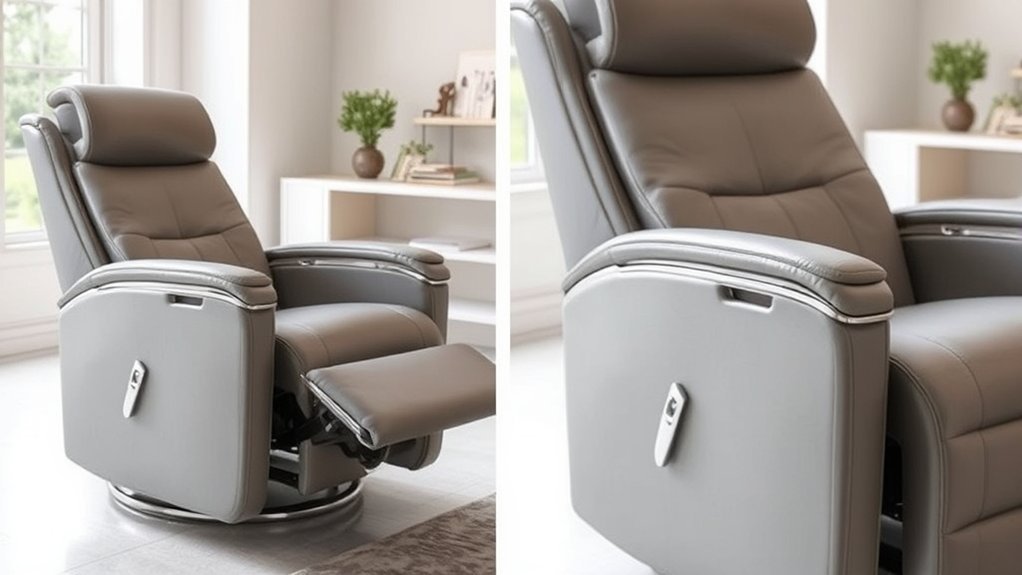Finding the right recline angle for your chair can greatly impact your comfort and productivity. You’ll want to explore angles from 90 to 180 degrees, paying close attention to how your body responds. Your back, neck, and legs will provide clues about your ideal position. As you experiment with these adjustments, consider the added elements of support that might enhance your experience. Understanding these nuances could lead to a more comfortable and productive setup.
Understanding Recline Angles
Recline angles play an essential role in defining comfort and support in seating arrangements, particularly in vehicles and aircraft. Understanding these angles is important for maximizing your seating experience. Typically measured in degrees, recline angles range from upright positions to more relaxed postures.
A steeper angle, closer to 90 degrees, offers better back support, while a lower angle promotes relaxation but may compromise spinal alignment.
You should consider how the recline angle affects your body’s weight distribution and pressure points. A favorable angle can enhance circulation and reduce fatigue during long journeys.
Factors Influencing Your Ideal Angle
Several factors can greatly impact your ideal recline angle, tailoring your seating experience to your personal needs.
First, consider your body type; taller individuals may require a different angle compared to shorter ones for optimal comfort.
Next, think about your intended activity. If you’re reading or watching TV, a more upright position might be ideal, while napping may call for a deeper recline.
Posture also plays a significant role; if you have back issues, a supportive angle that promotes spinal alignment is essential.
Finally, the chair’s design can influence your choice; features like lumbar support or adjustable headrests can enhance comfort at various angles.
Testing Different Recline Positions
How can you find the perfect recline position for your needs? Start by adjusting your chair to various angles, typically ranging from 90 to 180 degrees.
Test each position for a few minutes to gauge comfort and support. Pay attention to how your body feels—specifically your back, neck, and legs. Notice any tension or discomfort that arises.
You might also want to evaluate your posture in each position. Are your feet flat on the ground? Is your spine aligned?
Consider the activities you’ll perform while reclined, like reading or watching TV, and test accordingly. Document your findings for future reference.
This methodical approach will help you identify the recline position that best suits your personal comfort and support requirements.
Enhancing Comfort With Additional Support
Finding the right recline position is just the beginning of enhancing your overall comfort. To truly elevate your experience, consider adding supplementary support in key areas. This can greatly reduce strain and help you relax more fully.
Here are some effective options:
- Lumbar cushion for lower back support
- Neck pillow to maintain head alignment
- Footrest to elevate and relieve pressure on your legs
- Armrests to support your arms comfortably
- Blanket or throw for warmth and coziness
Incorporating these elements not only optimizes your recline angle but also creates an inviting environment that encourages relaxation.
Tips for Maintaining Your Preferred Angle
To guarantee you maintain your preferred recline angle throughout your relaxation time, it’s essential to regularly check and adjust your setup.
First, identify markers on your recliner or chair that indicate your desired angle. Use these as reference points to quickly realign when needed.
Consider investing in a recline angle gauge, which can provide precise measurements. If you find your angle shifting frequently, examine the chair’s mechanism for wear or looseness that may require tightening or lubrication.
Additionally, adjust your cushions or pillows to make certain they support your back and neck without forcing you into an unintended position.
Finally, make it a habit to reassess your comfort level periodically, especially after prolonged use, to maintain ideal relaxation.
Frequently Asked Questions
How Do I Measure the Recline Angle Accurately?
To measure the recline angle accurately, use a protractor or an inclinometer. Position it against the backrest, ensuring it’s level. Read the angle where the backrest meets the seat for precise measurements.
Can I Adjust the Recline Angle While Sitting?
Yes, you can adjust the recline angle while sitting, depending on your chair’s mechanism. Make sure to locate the adjustment lever or button, then gently lean back to achieve your desired angle comfortably.
What Are Common Recline Angles for Different Activities?
Most people prefer a recline angle of 30 to 45 degrees for relaxation and watching TV, while a 90-degree angle is ideal for working. Adjusting these angles enhances comfort and productivity during various activities.
Are There Specific Chairs Designed for Optimal Recline Angles?
Yes, there are specific chairs designed for ideal recline angles, such as ergonomic office chairs and recliners. These chairs often feature adjustable mechanisms, allowing you to find the most comfortable position for various activities.
Is There a Universal Standard for Recline Angles?
There isn’t a universal standard for recline angles, much like how preferences for comfort vary. Different chairs offer various angles, catering to individual needs, but no single measurement fits everyone’s idea of ideal relaxation.
Conclusion
To summarize, finding your ideal recline angle is essential for maximizing comfort and support. By methodically testing various positions and incorporating additional support, you can create a personalized seating experience that feels like a warm embrace after a long day. Remember, your preferred angle may evolve over time, so it’s wise to periodically reassess your setup. Stay attentive to your body’s signals, and you’ll guarantee your chair remains a sanctuary of relaxation.
